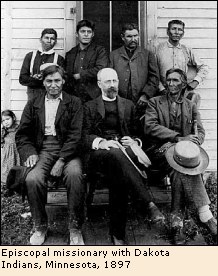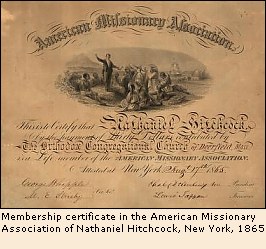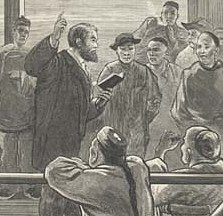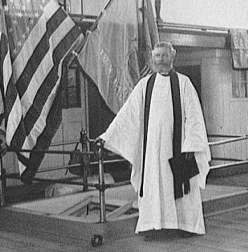The Foreign Missionary Movement
|
in the 19th and early 20th Centuries
Daniel H. Bays
History Dept. and Asian Studies Program, Calvin College
Professor Emeritus, Dept. of History, The University of Kansas
©National Humanities Center |
|
(part 4 of 4)
Guiding Student Discussion
To say the least, it may be difficult for students today to appreciate the intensity of belief and commitment that drove many Americans to "the mission field," whether domestic or foreign, beginning in the early nineteenth century (and even before, with Native American missions). You might remind them that whereas there were about 5,000 Americans working overseas as Christian missionaries in 1900, today there are close to 40,000. So people are still moved by the "Great Commission" that Jesus left with his followers 2000 years ago: "Go ye therefore and teach all nations" (Matthew 28:19). There are also now many more varieties of missionaries. Whereas nineteenth-century American missions were almost entirely Protestant, now there are large numbers of Roman Catholic missionaries, as well as Mormons, Jehovah's Witnesses, and others. You might ask them to figure out why there were no American Catholic foreign missions in the nineteenth century (America itself was still a Catholic mission field).
A good exercise might be to list images and descriptors that we have, or that may be current in our culture today, about missionaries. Some of them may have seen the fairly recent movies At Play in the Fields of the Lord (1991), Mosquito Coast (1986)—both with negative images—or The Mission (1986), with a positive image. The list might include terms like arrogant, dedicated, idealistic, intolerant, pious, and in a lighter vein, images of pith hats, being cooked in a big pot by cannibals, even references to the "missionary position." You can include images of the town parson which are common in movies about the American West; the parson generally tries to bring civilization, a school, etc. Can students appreciate that the foreign missionary movement is in many ways an extension of this frontier parson in the expanding American West?
The foreign missionary movement's provisions of jobs and social roles for American women denied to them at home is a fertile topic for discussion. Take a year, say 1850, and have the students pitch in to make a list of the social, economic, administrative, or managerial roles and professions which an American woman could realistically hope to pursue at home. Then discuss all the jobs and roles and responsibilities available on the mission field (there were lots, probably far more than at home, even though women were often denied formal voting rights in mission bodies).
How to get students who are notoriously loath to condemn anyone else's values, often saying "whatever works for you," to appreciate the missionary's single-minded intensity and exclusivity of commitment to Christianity and its accompanying cultural baggage of individualism, self-betterment, and republicanism? Have them think of recent or contemporary analogues—isn't the Peace Corps overseas, or the Job Corps working in Appalachia or inner cities, rather similar in tone? Doesn't the U.S. government and U.S. public opinion today preach a form of the Gospel in the belief that all nations should respect the basic human rights of their citizens? If nineteenth-century missionaries were "intolerant" towards foreign cultures, isn't it also "intolerant" of us constantly to criticize China and other foreign countries for abusing and persecuting their own citizens if they wish?
Many Americans think it's horrible that certain African cultures today practice forced clitoral circumcision on young girls, an extremely painful and permanently disfiguring procedure. Is that different from missionaries a hundred years ago criticizing foreign cultures—for example, in India denouncing as barbarous the cultural practice of suttee (the burning of a widow, often against her will, on the funeral pyre of her deceased husband)? Or in China reviling as uncivilized the practice of "footbinding," whereby the feet of young girls are tightly bound, bent under, and permanently crippled? Should missionaries not have criticized these things? Should we not criticize abuses of human rights today? Are people who get very upset about these things and dedicate their lives to changing them fanatics or idealists? Are they improperly overstepping cultural bounds, or are they taking commendable moral responsibility to make a difference in the world? When we have the truth, aren't we obligated to pass it on? When do we know we have the truth? Many Americans of the nineteenth century firmly believed they had the truth of the Christian message. Weren't they obliged to pass it on? But when they did pass on the message of Christ, why did they also build schools, hospitals and orphanages? Hopefully this line of discussion will open up some lively interchanges.
It's also useful to show the students that even during the nineteenth century there were some Americans who had second thoughts about the aggressive religious expansionism of the foreign missionary movement. There are Herman Melville's short stories Omoo and Typee, and Mark Twain's famous turn-of-the-century essay "To a Person Sitting in Darkness." Another well-known piece by Twain, A Connecticut Yankee in King Arthur's Court, can be read as a parody on both missionaries and the perils of bringing "civilization" to non-Western lands.
Historians Debate
Until the 1960s, the overwhelmingly dominant interpretation of nineteenth and early twentieth century American expansionism at home and abroad was that in addition to the Christian gospel, the religious or missionary element reinforced and manifested the "national mission" of the expansion and transfer overseas of American civilization—democracy and individual rights, the individual conscience, voluntary associations, social and economic free enterprise. It all looked fairly benign. An example of this scholarship would be the classic writings of Kenneth Scott Latourette, in particular sections on U.S. missions in The Great Century, 1800-1914, Vols. 4-6 of A History of the Expansion of Christianity (7 Vols., 1938-1946), or R. Pierce Beaver's essay, "Missionary Motivation through Three Centuries," in Jerald C. Brauer, ed., Reinterpretation in American Church History (1968).
A dramatic change occurred in the late 1960s and 1970s. In the aftermath of the U.S. domestic civil rights movement and especially disillusionment with the Vietnam War, scholars took a jaundiced look at the religious expansionism of earlier decades, seeing it as part and parcel of, among other things, cultural aggression against Native Americans, paternalism towards the aspirations of African Americans, and as being in cahoots with military and economic imperialism around the globe. Thus charges of cultural imperialism against missionaries were common in these years. For one such critique, see Arthur Schlesinger, Jr., "The Missionary Enterprise and Theories of Imperialism," in John K. Fairbank, ed., The Missionary Enterprise in China and America (1974). A more nuanced discussion is William R. Hutchison, "A Moral Equivalent for Imperialism," chapter four of his superb study, Errand to the World: American Protestant Thought and Foreign Missions (1987).
From the 1980s to the present, mission studies have benefited from the attention of scholars participating in the renaissance of historical studies of American evangelicalism, as well as in the rethinking of the world missionary movement and the American role in it. For example, we have learned that in the late nineteenth century, long before anyone was worried about the wickedness of imperialism, new evangelical faith missions were dissenting from the dominant mainline mission orthodoxy of civilization accompanying the gospel and doing much less in the way of educational and medical work, focusing on the religious message of Christianity. That is, perhaps some missionaries did resist the urge to export American civilization.
Moreover, two very hot areas of American historical study in the past two decades, ethnicity and women, have benefited greatly from studies of missions and missionaries, taking advantage of the detailed historical records of some mission bodies now available in archives. A fine study of American women in mission, including Catholics, is Dana L. Robert, American Women in Mission: A Social History of Their Thought and Practice (1996).
And two thoughtful pieces with many insights on a whole range of historical issues relating to the interpretation of the role of foreign missions in American history are Dana L. Robert, "From Missions to Mission to Beyond Missions: The Historiography of American Protestant Foreign Missions since World War II," in Harry S. Stout and D. G. Hart, eds., New Directions in American Religious History (1997); and Andrew F. Walls, "The American Dimension in the History of the Missionary Movement," in Joel A. Carpenter and Wilbert R. Shenk, eds., Earthen Vessels: American Evangelicals and Foreign Missions, 1880-1980 (1990), reprinted in Walls, The Missionary Movement in Christian History (1996). A recent compilation of scholarship on the domestic significance of foreign missions from the nineteenth century through the Vietnam War is The Foreign Missionary Enterprise at Home: Explorations in North American Cultural History (eds., Daniel H. Bays and Grant Wacker, 2003).
Daniel H. Bays is Professor of History and Director of the Asian Studies Program at Calvin College, Grand Rapids, Michigan. He is Professor Emeritus of the University of Kansas, where he chaired the History Department. His major publications include China Enters the Twentieth Century (1978), Christianity in China: From the Eighteenth Century to the Present (ed., 1996), The Foreign Missionary Enterprise at Home: Explorations in North American Cultural History (co-editor with Grant Wacker, 2003), and numerous articles including "Chinese Protestant Christianity Today," The China Quarterly (2003). He has held an NEH fellowship (1973), two Fulbright-Hays research grants to Taiwan (1977-78, 1984-85), and a National Academy of Sciences grant for research in China (1986). He has directed major research projects, funded by the Henry Luce Foundation and the Pew Charitable Trusts, on the history of Christianity in China and American missionary movements.
Address comments or questions to Professor Bays through TeacherServe "Comments and Questions."
TeacherServe Home Page
National Humanities Center Home Page
7 Alexander Drive, P.O. Box 12256
Research Triangle Park, North Carolina 27709
Phone: (919) 549-0661 Fax: (919) 990-8535
Revised: September 2005
nationalhumanitiescenter.org |


Links to Online Resources
Works Cited
Illustration Credits
Comments & Questions





